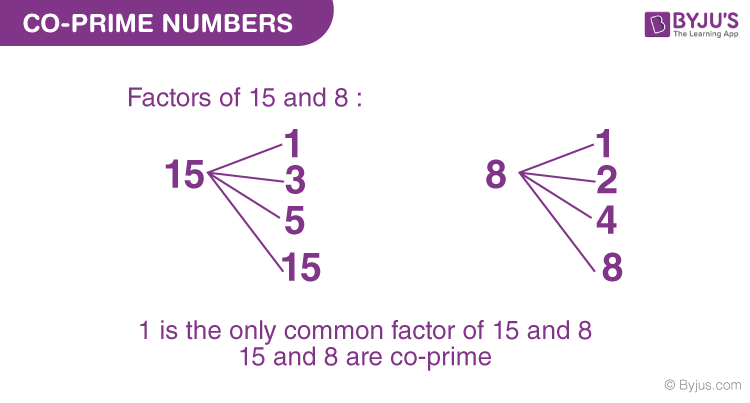Co-Prime Numbers
Co prime numbers are those numbers that have only one common factor, namely 1. That means a pair of numbers are said to be co prime when they have their highest common factor as 1. There are different ways to define co-prime numbers. In this article, you will understand what are coprime numbers in Maths, how to identify the co prime number using simple tricks and tips along with the examples.
| Table of Contents: |
Let’s have a look at the co prime numbers definition in mathematical terms along with the representation.
What are Co-Prime Numbers?
Suppose x and y are two positive integers such that they are called co prime numbers if and only if they have 1 as their only common factor and thus HCF(x, y) = 1. In other words, Co-prime numbers are a set of numbers or integers which have only 1 as their common factor i.e. their highest common factor (HCF) will be 1. Co-prime numbers are also known as relatively prime or mutually prime numbers. It is important that there should be two numbers in order to form co-primes.
Check: What is Mathematics?
How to Find Co-prime Numbers?
Consider a set of two numbers, if they have no positive integer that can divide both, other than 1, the pair of numbers is co-prime.
Example 1: 21 and 22
For 21 and 22:
- The factors of 21 are 1, 3, 7, and 21.
- The factors of 22 are 1, 2, 11, and 22.
Here 21 and 22 have only one common factor that is 1. Hence, their HCF is 1 and are co-prime.
Example 2: 21 and 27
For 21 and 27:
- The factors of 21 are 1, 3, 7, and 21.
- The factors of 27 are 1, 3, 9, and 27.
Here 21 and 27 have two common factors; they are 1 and 3. HCF is 3 and they are not co-prime.
Co prime Numbers List
The below table shows the list of co prime numbers.
| Co prime with | Co prime numbers pairs |
| 1 | (1, 2), (1, 3), (1, 4), (1, 5) (1, 6),….., (1, 20),…. |
| 2 | (2, 3), (2, 5), (2, 7), (2, 9), …, (2, 15),….. |
| 3 | (3, 4), (3, 5), (3, 7), (3, 10), (3, 11),…., (3, 20),… |
| 4 | (4, 5), (4, 7), (4, 9), (4, 11), (4, 13), (4, 15),…. |
| 5 | (5, 6), (5, 7), (5, 8), (5, 9), (5, 11), (5, 12),… |
Properties of Co-Prime Numbers
Some of the properties of co-prime numbers are as follows. These are called tricks to identify the pairs of co prime numbers quickly.
- 1 is co-prime with every number.
- Any two prime numbers are co-prime to each other: As every prime number has only two factors 1 and the number itself, the only common factor of two prime numbers will be 1. For example, 2 and 3 are two prime numbers. Factors of 2 are 1, 2, and factors of 3 are 1, 3. The only common factor is 1 and hence they are co-prime.
- Any two successive numbers/ integers are always co-prime: Take any consecutive numbers such as 2, 3, or 3, 4 or 5, 6, and so on; they have 1 as their HCF.
- The sum of any two co-prime numbers are always co-prime with their product: 2 and 3 are co-prime and have 5 as their sum (2+3) and 6 as the product (2×3). Hence, 5 and 6 are co-prime to each other.
- Two even numbers can never form a coprime pair as all the even numbers have a common factor as 2.
- If two numbers have their unit digits as 0 and 5, then they are not coprime to each other. For example 10 and 15 are not coprime since their HCF is 5 (or divisible by 5).
Co prime Numbers from 1 to 100
There are several pairs of co-primes from 1 to 100 which follow the above properties. Some of them are:
(13, 14)
(28, 57)
(1, 99)
(2, 97)
(46, 67)
(75, 41) and so on.
Also, we can write any number with the combination of 1 as a coprime pair such as (22, 1), (31, 1), (4, 1), (90, 1), (1, 100). In this way, many coprime numbers are defined from 1 to 100.
Co Prime Numbers and Twin Prime Numbers
We know that coprime numbers are the numbers whose HCF is 1, (i.e.) two numbers whose common factor is 1 only are called co prime numbers. On the other hand, twin prime numbers are the prime numbers whose difference is always equal to 2. For example, the difference between 3 and 5 is 2, and hence 3 and 5 are twin prime numbers. The major difference between twin prime and co-prime numbers are as follows:
- The difference between two twin prime numbers is always equal to 2, whereas the difference between two co-prime numbers can be any number.
- Twin prime numbers are always prime numbers, whereas the co-prime numbers can also be a composite number.
Video Lesson
Twin Primes and Co-Primes

Go through the co prime numbers examples given below for a better understanding of the concept.
Example Question Related to Co prime Numbers
Question 1:
Check whether 13 and 31 are co-prime.
Solution:
13 and 31 are two prime numbers; therefore, they are co-prime to each other. (Property 2)
The factors of 13 are 1, 13 and the factors of 31 are 1, 31.
They have only 1 as their common factor. So, they are coprime numbers.
Question 2:
Check whether 150 and 295 are co primes.
Solution:
Given two number are: 150 and 295
150 and 295 are divisible by 5.
From the properties of coprime numbers, 150 and 295 are not coprime.
Alternatively,
150 = 2 × 3 × 5 × 5
295 = 5 × 59
HCF(150, 295) = 5 ≠ 1
Therefore, 150 and 295 are not coprime.
Practice Problems
- Write any one co prime number of 216 and 215.
- Are 35 and 37 co prime?
- 41 and 44 are co prime numbers. True or false.
Frequently Asked Questions on Co Prime Numbers
What are Co-prime Numbers?
Co-prime numbers or relatively prime numbers are those numbers that have their HCF (Highest Common Factor) as 1. In other words, two numbers are co-prime if they no common factor other than 1.
What is the difference between prime and Coprime numbers?
A prime number is defined as a number that has no factor other than 1 and itself. On the contrary, co-primes are considered in pairs and two numbers are co-prime if they have no common factors other than 1.
How do you Find the Co-prime of a Number?
To find the co-prime of a number, find the factors of the number first. Then, choose any number and find the factors of the chosen number. All the numbers which do not have any common factor other than 1 will be the co-prime of the given number.
Are 18 and 35 Coprime Numbers?
Yes, 18 and 35 are co-prime numbers. The factors of 18 are 1, 2, 3, 6, 9, and 18 while the factors of 35 are 1, 5, 7, and 35. Since the HCF is 1, they are coprime.
Is 1 Coprime to All numbers?
Yes, 1 is coprime to all the numbers. Since HCF of 1 and any number is 1 itself. Hence, by the definition of coprime numbers, 1 said to be coprime with all numbers.

